
Rhododendron is a very large genus of 1,024 species of woody plants in the heath family (Ericaceae), either evergreen or deciduous, and found mainly in Asia, although it is also widespread throughout lowland and montane forests in the Pacific Northwest, California, the Northeastern United States, and especially in the highlands of the Appalachian Mountains of North America. It is the national flower of Nepal, the state flower of Washington and West Virginia in the United States, the provincial flower of Jiangxi in China and the state tree of Sikkim and Uttarakhand in India. Most species have brightly colored flowers which bloom from late winter through to early summer.

Osmunda is a genus of primarily temperate-zone ferns of family Osmundaceae. Five to ten species have been listed for this genus.

Nothofagus, also known as the southern beeches, is a genus of 43 species of trees and shrubs native to the Southern Hemisphere in southern South America and Australasia. The species are ecological dominants in many temperate forests in these regions. Some species are reportedly naturalised in Germany and Great Britain. The genus has a rich fossil record of leaves, cupules, and pollen, with fossils extending into the late Cretaceous period and occurring in Australia, New Zealand, Antarctica, and South America. In the past, they were included in the family Fagaceae, but genetic tests revealed them to be genetically distinct, and they are now included in their own family, the Nothofagaceae.

In biology, a type is a particular specimen of an organism to which the scientific name of that organism is formally attached. In other words, a type is an example that serves to anchor or centralize the defining features of that particular taxon. In older usage, a type was a taxon rather than a specimen.
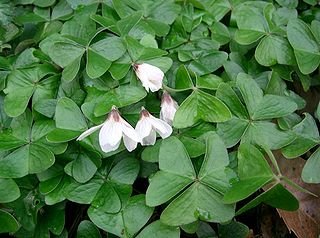
Oxalis or is a large genus of flowering plants in the wood-sorrel family Oxalidaceae, comprising about 570 species. The genus occurs throughout most of the world, except for the polar areas; species diversity is particularly rich in tropical Brazil, Mexico and South Africa.

Banksia subg. Isostylis is a subgenus of Banksia. It contains three closely related species, all of which occur only in Southwest Western Australia. Members of subgenus Isostylis have dome-shaped flower heads that are superficially similar to those of B. ser. Dryandra, but structurally more like reduced versions of the "flower spikes" characteristic of most other Banksia taxa.

William Henry Harvey, FRS FLS was an Irish botanist and phycologist who specialised in algae.
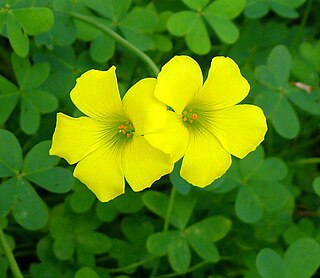
Oxalis pes-caprae is a species of tristylous flowering plant in the wood sorrel family Oxalidaceae. Oxalis cernua is a less common synonym for this species.

Phormium colensoi (syn. Phormium cookianum ; wharariki, whararipi, whatariki, mangaeka, kōrari tuauru, wauraki, mountain flax, coastal flax, hill flax, lesser New Zealand flax, is a perennial plant that is endemic to Aotearoa New Zealand. It is less common than the other Phormium species, harakeke P. tenax J.R.Forst. et G.Forst. The greenish, yellow or orange flowers are followed by twisted seed pods.
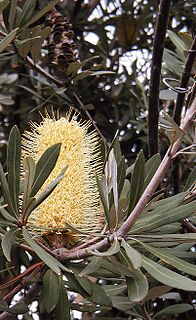
The taxonomy of Banksia integrifolia has a long and complex history, the result of confusion caused by the species' great variability, and similarities with some closely related species. The existence of hybrids between B. integrifolia and related species as well as early attempts to classify the species based on dried specimen material have also contributed to the confusion.

Priority is a fundamental principle of modern botanical nomenclature and zoological nomenclature. Essentially, it is the principle of recognising the first valid application of a name to a plant or animal. There are two aspects to this:
- The first formal scientific name given to a plant or animal taxon shall be the name that is to be used, called the valid name in zoology and correct name in botany.
- Once a name has been used, no subsequent publication of that name for another taxon shall be valid (zoology) or validly published (botany).

The fiery squirrel is a rodent in the family Sciuridae. The taxon is endemic to the area south of the Orinoco River in the state of Bolívar, Venezuela.

In biological classification, taxonomic rank is the relative level of a group of organisms in a taxonomic hierarchy. Examples of taxonomic ranks are species, genus, family, order, class, phylum, kingdom, domain, etc.

Cortinarius archeri is a species of mushroom in the genus Cortinarius native to Australia. The distinctive mushrooms have bright purple caps that glisten with slime, and appear in autumn in eucalypt forests.

Cercidoideae is a subfamily in the pea family, Fabaceae. Well-known members include Cercis (redbuds), including species widely cultivated as ornamental trees in the United States and Europe, Bauhinia, widely cultivated as an ornamental tree in tropical Asia, and Tylosema esculentum, a traditional food crop in Africa. The subfamily occupies a basal position within the Fabaceae and is supported as monophyletic in many molecular phylogenies. At the 6th International Legume Conference, the Legume Phylogeny Working Group proposed elevating the tribe Cercidae to the level of subfamily within the Leguminosae (Fabaceae). The consensus agreed to the change, which was fully implemented in 2017. It has the following clade-based definition:
The most inclusive crown clade containing Cercis canadensisL. and Bauhinia divaricataL. but not Poeppigia proceraC.Presl, Duparquetia orchidaceaBaill., or Bobgunnia fistuloides(Harms) J.H.Kirkbr. & Wiersema.

Sebaea is a genus of annual plants in the family Gentianaceae. Species occur in Africa, Madagascar, India, China, Thailand, Australia and New Zealand. The genus was paraphyletic and has been split in four genera: Exochaenium, Klackenbergia, Lagenias and Sebaeas.str.. Synapomorphies for Sebaea s.str. include the presence of extra stigma along the style and the shape of the testa cells of the seeds.
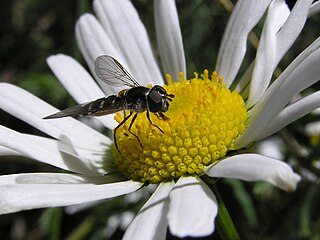
Melangyna novaezelandiae is a hoverfly endemic to New Zealand. It is a generalized pollinator of a large range of plants that are both native and exotic to the New Zealand flora. M. novaezelandiae is widespread throughout New Zealand, including in agricultural environments. The larvae of this species feeds on other arthropods and may have uses as a biocontrol agent.

Lactifluus is one of three genera of mushroom-forming fungi containing species commonly named "milk-caps", the others being Lactarius and Multifurca. It has been separated from Lactarius based on molecular phylogenetic evidence but is very similar to that genus. There are roughly 150 known Lactifluus species, which have a mainly tropical distribution but are also found in the north temperate zone and Australasia. Some of them are edible mushrooms.
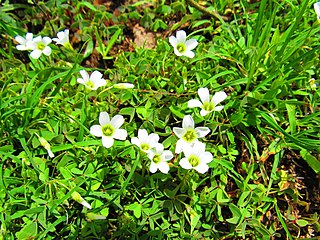
Oxalis alpina, also known by its common name alpine woodsorrel, is a species from the genus Oxalis.
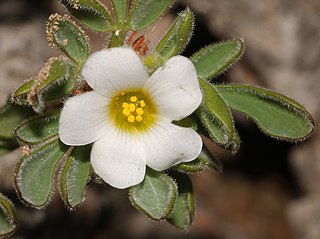
Oxalis virginea, commonly known as Virgin sorrel, is a species from the genus Oxalis. It is endemic to South Africa. O. virginea was first described by Nikolaus Joseph von Jacquin in 1798. This species is apparently lacking a type specimen.




















